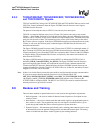
274 Hardware Reference Manual
Intel
®
IXP2800 Network Processor
Media and Switch Fabric Interface
8.3.5.2 CSIX
8.3.5.2.1 Horizontal Parity
The transmit logic computes odd Horizontal Parity for each transmitted 16-bits of each Cword, and
transmits it on TxPar.
8.3.5.2.2 Vertical Parity
The transmit logic computes Vertical Parity on CFrames. There is a 16-bit VP Accumulator
register. At the beginning of each CFrame, the register is cleared. As each Cword is transmitted,
odd parity is accumulated in the register as defined in the CSIX specification (16 bits of vertical
parity are formed on 32 bits of transmitted data by treating the data as words; i.e., bit 0 and bit 16 of
the data are accumulated into parity bit 0, bit 1, and bit 17 of the data are accumulated into parity
bit 1, etc.). The accumulated value is transmitted in the Cword along with the last byte of Payload
and any padding, if required.
8.4 RBUF and TBUF Summary
Table 102 summarizes and contrasts the RBUF and TBUF operations.
Table 102. Summary of RBUF and TBUF Operations (Sheet 1 of 2)
Operation RBUF TBUF
Allocate element
SPI-4
Hardware allocates an element upon receipt of a
non-idle Control Word, or when a previous element
becomes full and another Data Word arrives with no
intervening Control Word. Any available element in
the SPI-4 partition may be allocated, however,
elements are guaranteed to be handed to threads in
the order in which they arrive.
CSIX
Hardware allocates an element upon receipt of
RxSof asserted. Any available element in the CSIX
Control or CSIX Data partition may be allocated
(according to the type), however, elements are
guaranteed to be handed to threads in the order in
which they arrive.
Microengine allocates an element. Because the
elements are transmitted in FIFO order (within each
TBUF partition), the Microengine can keep the
number of the next element in software.
Fill element
SPI-4
Hardware fills the element with Data Words.
CSIX
Hardware fills the element with Payload.
Microcode fills the element from DRAM using the
dram[tbuf_wr] instruction and from Microengine
registers using msf[write] instruction.
Set element valid
SPI-4
Set valid by hardware when either it becomes full or
when a Control Word is received.
CSIX
Set valid by hardware when the number of bytes in
Payload Length have been received.
The element’s Transmit Valid bit is set. This is done
by a write to the TBUF_Element_Control_$_# CSR
($is A or B, # is the element number).


















